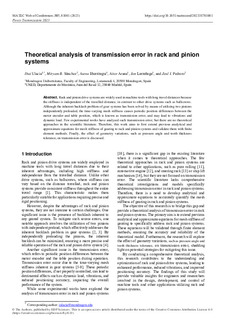Izenburua
Theoretical analysis of transmission error in rack and pinion systemsBeste instituzio
Universidad Nacional de Educación a Distancia (UNED)Bertsioa
Bertsio argitaratua
Eskubideak
© 2023 The AuthorsSarbidea
Sarbide irekiaArgitaratzailearen bertsioa
https://doi.org/10.1051/matecconf/202338701001Non argitaratua
9th International BAPT Conference “Power Transmissions 2023”. MATEC Web of Conferences Vol. 387. N. art. 01001, 2023Argitaratzailea
EDP SciencesGako-hitzak
ODS 9 Industria, innovación e infraestructuraODS 12 Producción y consumo responsables
Laburpena
Rack and pinion drive systems are widely used in machine tools with long travel distances because the stiffness is independent of the travelled distance, in contrast to other drive systems such as bal ... [+]
Rack and pinion drive systems are widely used in machine tools with long travel distances because the stiffness is independent of the travelled distance, in contrast to other drive systems such as ballscrews. Although the inherent backlash problem of gear systems has been solved by means of utilizing two pinions independently preloaded, the time-varying mesh stiffness causes periodic position differences between the motor encoder and table position, which is known as transmission error, and may lead to vibrations and dynamic load. Few experimental works have analyzed such transmission error, but there are no theoretical approaches in the scientific literature. Therefore, this work aims to first extend previous analytical and approximate equations for mesh stiffness of gearing to rack and pinion systems and validate them with finite element methods. Finally, the effect of geometry variations, such as pressure angle and tooth thickness tolerance, on transmission error is discussed. [-]
Bildumak
Item honek honako baimen-fitxategi hauek dauzka asoziatuta:






















